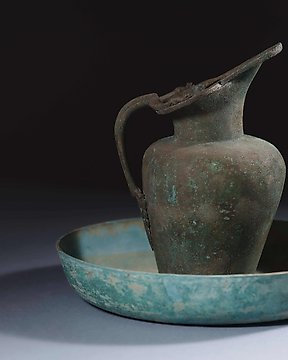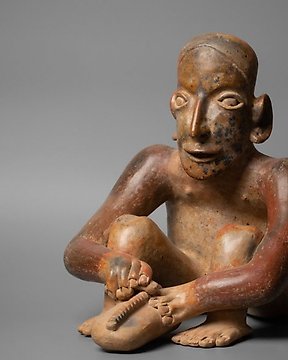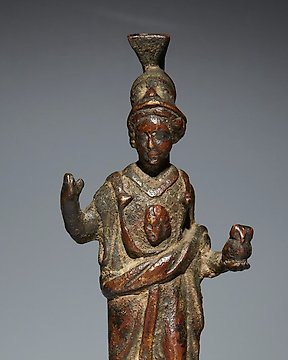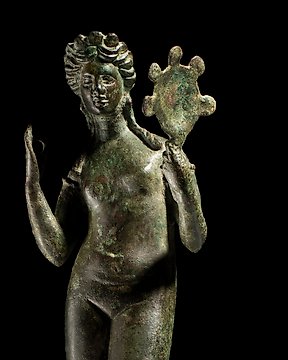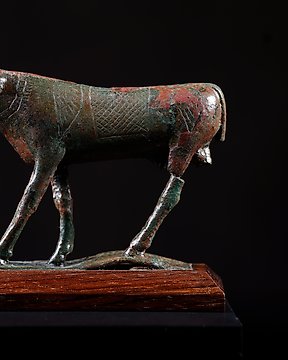Wunderbares Stück. Alles wie beschrieben. Hervorragender Kontakt.
Katso käännösMuinainen Kreikka Pronssi Hieno Panin jumalan pää. hellenismi. 5. vuosisadalla eaa. 9,5 cm H.
Nro. 85410997
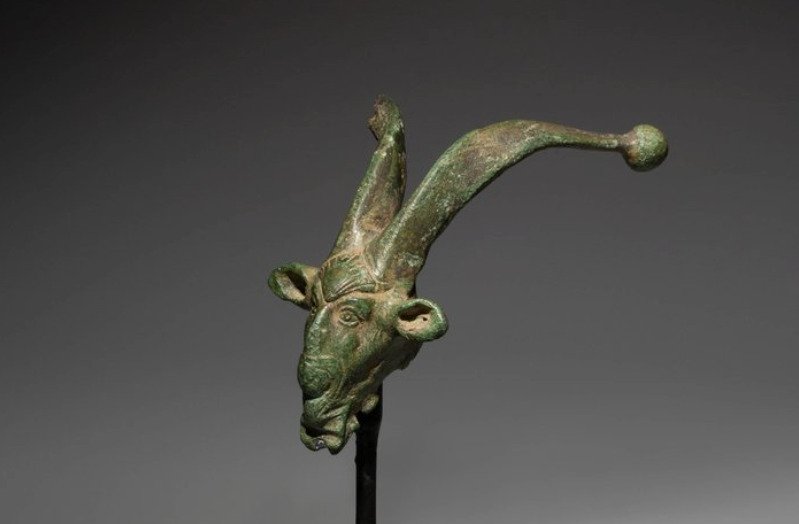
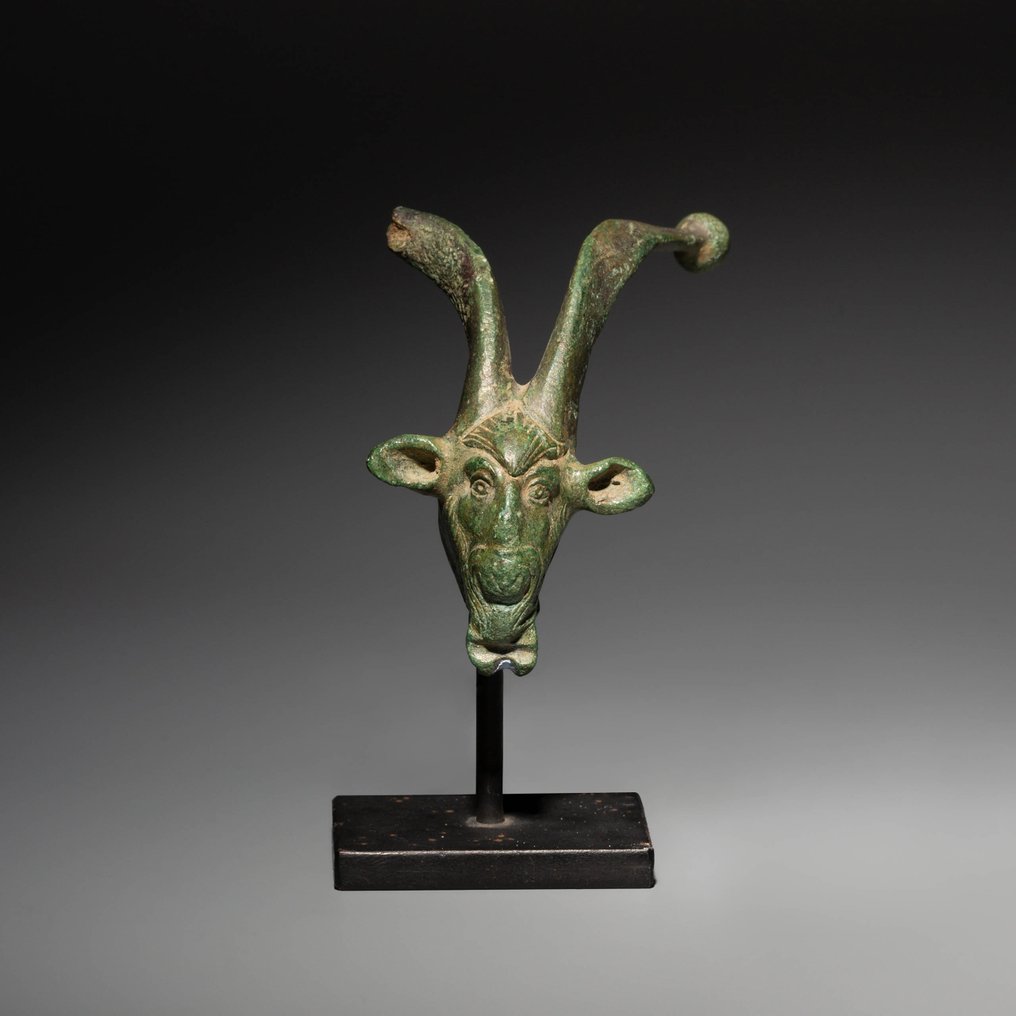

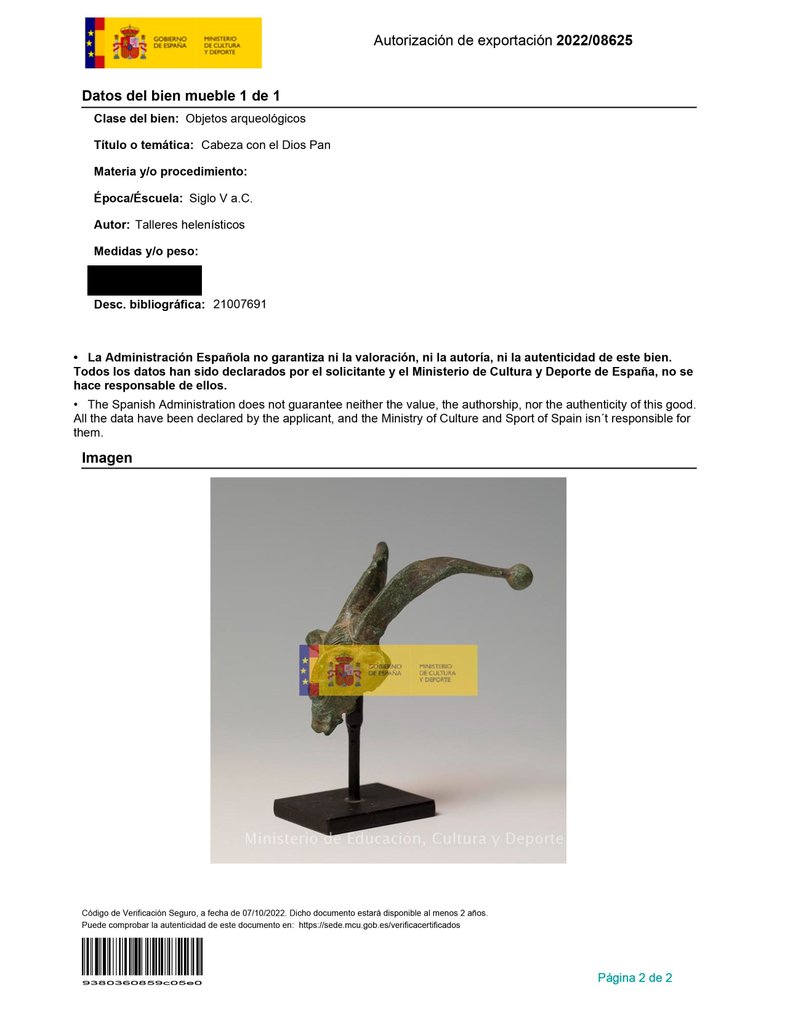


Head of the god Pan.
- nice quality -
Ancient Greece, Helenistic period, 5th century BC.
Bronze.
9.5 cm height without stand.
Condition: Good condition. A horn is missing.
Provenance: Private collection, A.A., Brussels. Acquired from Naxos Art Limited, London in 1996. A copy of the bill of sale is attached.
Private collection, Estepona, Malaga.
Wall light made of lost wax bronze, half-bulk, representing the head of the god Pan. It would originally be an ornament added to a larger object, such as a glass, a piece of furniture or a carriage. Pan is represented in his most animalistic aspect, with a caprine head with large horns ending in balls, large ears and a flat nose, elongated like a snout. The modeling is careful and naturalistic, and is complemented by cold chiselling work for details such as the texture of the fur.
Personification of lust, wild god of fertility, protector of herds and symbol of sexual potency, Pan was considered to come from Arcadia and the son of Hermes and a nymph from that region. Fearsome deity, he was sometimes capable of causing the so-called "panic terror", so his help was often invoked in battles to frighten the enemy. He was described as an animal-looking being, with goat's horns and shaggy hair and beard, although he was appreciated by the gods due to the beauty of the music he played on his reed flute, the syrinx or Pan's flute. In older representations of a certain complexity, found in Athens from the 6th century BC, it is depicted with the head of a goat, an erect phallus and the feet or legs of a goat. He will soon be related to the Dionysian cult, and from the Late Classicism, he will join the procession of Dionysus. With the passage of time he will acquire a more human and even pleasant appearance, although most of the representations of Pan will retain the animal face with a flattened, aquiline nose, pointed ears and a large, meaty mouth.
The Homeric Hymn to Pan related the god to the concept of totality, due to his name (pan means “all” in Greek), an idea that Boccaccio took up again in the 14th century. Hand in hand with him, humanists will use the figure of this god, both for his name and for his hybrid nature, as a symbol of universal Nature in its original state of chaos, developing the idea of the so-called Cosmic Pan. Alciato will later interpret Pan as a synonym for Nature, considering the lower part of his body a representation of the union with the animal world and the upper part of the relationship with divinity.
Lost wax casting is a very difficult procedure for making metal pieces, which requires careful planning and coordination between the sculptor, the molder and the caster. The first step consists in the elaboration of the prototype of the object in wax, perfectly finished in all its details, including the polishing. Channels, vents and an inlet cone are added to this model and lined with refractory clay. Once the clay dries, heat is applied and the wax melts, evacuating the ceramic container that has taken its negative shape through the channels. Thus, a mold is obtained that is filled with molten metal through the inlet cone, spreading out evenly thanks to the vents. Finally, once the metal has solidified, the ceramic coating is broken to release the finished part. It is, therefore, a technique that only allows the creation of unique pieces.
PARALLELS:
Fig. 1 Wall lamp in the shape of a goat's head. Greece, ss. III-I BC, bronze. Cleveland Museum of Art (USA), inv. 1940.666.
Fig. 2 Jug handle in the shape of the god Pan. Greece, h. 480-450 B.C., bronze. British Museum, London, inv. 1918.0101.22.
Fig. 3 Jug handle in the shape of the god Pan. Greece, h. 480-450 B.C., bronze. British Museum, London, inv. 1918.0101.22.
Notes:
- The piece includes authenticity certificate.
- The piece includes Spanish Export License (Passport for European Union). NOT TAXES.
- According to Spanish legislation, items sent outside the European Union are subject to export taxes and will be added to the invoice, at the buyer's expense. These export fees are fixed on the final auction price and the tax rate is not applied directly on the total value of the item to be exported, but rather the different percentages by sections are applied to it:
- Up to 6,000 euros: 5%.
- From 6.001 to 60.000 euros: 10%.
This export permit application process can take between 1-2 months maximum.
- The seller guarantees that he acquired this piece according to all national and international laws related to the ownership of cultural property. Provenance statement seen by Catawiki.
#ancientcivilisations
Myyjän tarina
Head of the god Pan.
- nice quality -
Ancient Greece, Helenistic period, 5th century BC.
Bronze.
9.5 cm height without stand.
Condition: Good condition. A horn is missing.
Provenance: Private collection, A.A., Brussels. Acquired from Naxos Art Limited, London in 1996. A copy of the bill of sale is attached.
Private collection, Estepona, Malaga.
Wall light made of lost wax bronze, half-bulk, representing the head of the god Pan. It would originally be an ornament added to a larger object, such as a glass, a piece of furniture or a carriage. Pan is represented in his most animalistic aspect, with a caprine head with large horns ending in balls, large ears and a flat nose, elongated like a snout. The modeling is careful and naturalistic, and is complemented by cold chiselling work for details such as the texture of the fur.
Personification of lust, wild god of fertility, protector of herds and symbol of sexual potency, Pan was considered to come from Arcadia and the son of Hermes and a nymph from that region. Fearsome deity, he was sometimes capable of causing the so-called "panic terror", so his help was often invoked in battles to frighten the enemy. He was described as an animal-looking being, with goat's horns and shaggy hair and beard, although he was appreciated by the gods due to the beauty of the music he played on his reed flute, the syrinx or Pan's flute. In older representations of a certain complexity, found in Athens from the 6th century BC, it is depicted with the head of a goat, an erect phallus and the feet or legs of a goat. He will soon be related to the Dionysian cult, and from the Late Classicism, he will join the procession of Dionysus. With the passage of time he will acquire a more human and even pleasant appearance, although most of the representations of Pan will retain the animal face with a flattened, aquiline nose, pointed ears and a large, meaty mouth.
The Homeric Hymn to Pan related the god to the concept of totality, due to his name (pan means “all” in Greek), an idea that Boccaccio took up again in the 14th century. Hand in hand with him, humanists will use the figure of this god, both for his name and for his hybrid nature, as a symbol of universal Nature in its original state of chaos, developing the idea of the so-called Cosmic Pan. Alciato will later interpret Pan as a synonym for Nature, considering the lower part of his body a representation of the union with the animal world and the upper part of the relationship with divinity.
Lost wax casting is a very difficult procedure for making metal pieces, which requires careful planning and coordination between the sculptor, the molder and the caster. The first step consists in the elaboration of the prototype of the object in wax, perfectly finished in all its details, including the polishing. Channels, vents and an inlet cone are added to this model and lined with refractory clay. Once the clay dries, heat is applied and the wax melts, evacuating the ceramic container that has taken its negative shape through the channels. Thus, a mold is obtained that is filled with molten metal through the inlet cone, spreading out evenly thanks to the vents. Finally, once the metal has solidified, the ceramic coating is broken to release the finished part. It is, therefore, a technique that only allows the creation of unique pieces.
PARALLELS:
Fig. 1 Wall lamp in the shape of a goat's head. Greece, ss. III-I BC, bronze. Cleveland Museum of Art (USA), inv. 1940.666.
Fig. 2 Jug handle in the shape of the god Pan. Greece, h. 480-450 B.C., bronze. British Museum, London, inv. 1918.0101.22.
Fig. 3 Jug handle in the shape of the god Pan. Greece, h. 480-450 B.C., bronze. British Museum, London, inv. 1918.0101.22.
Notes:
- The piece includes authenticity certificate.
- The piece includes Spanish Export License (Passport for European Union). NOT TAXES.
- According to Spanish legislation, items sent outside the European Union are subject to export taxes and will be added to the invoice, at the buyer's expense. These export fees are fixed on the final auction price and the tax rate is not applied directly on the total value of the item to be exported, but rather the different percentages by sections are applied to it:
- Up to 6,000 euros: 5%.
- From 6.001 to 60.000 euros: 10%.
This export permit application process can take between 1-2 months maximum.
- The seller guarantees that he acquired this piece according to all national and international laws related to the ownership of cultural property. Provenance statement seen by Catawiki.
#ancientcivilisations
Myyjän tarina
- 752
- 7
- 0
Extremely rapid courrier service from Barcelona to Flanders, picture was nicely and carefully packaged. Muchas gracias!
Katso käännösVery fine specimen! Thanks.
Katso käännösgoede foto's, goede omschrijving, goed verpakt en snel verzonden.
Katso käännösmolto bello tutto ok
Katso käännösPezzo come da descrizione, davvero notevole. Venditore molto consigliato in quanto gentile e disponibile. spedizione molto veloce. Ottimo!
Katso käännösVenditore davvero ottimo e gentile. Merce come da descrizione, spedizione veloce. Ottimo l'avere certificato di autenticità.
Katso käännösUn 100 como empresa un 100 como envío . Empresa muy especial con mucha exquisitez en todos los productos y en personal . Muchas gracias
Katso käännösAll well! Thanks.
Katso käännösVery nice and fine cut little jewel! Well packed too! Thanks!
Katso käännösnice piece and very fast shipping!
Katso käännösEs una maravilla de moneda, donde se le nota los pasos de los años y me encanta. Servido muy rápido y bien empaquetado. Con su certificación. Qué más se puede pedir?
Katso käännösSnelle en correcte levering, alleen was de verpakking voor het schilderij niet stevig genoeg.
Katso käännösHerzlichen Dank!
Katso käännösAll OK and with very fast shipping.
Katso käännösPrachtig schilderij. Zo blij mee. Zeer nette verkoper en zeer snelle levering.
Katso käännösperfect ! very fast and high quality delivery !
Katso käännösAll well! Thanks.
Katso käännösVendeur très professionnel, top +++×
Katso käännösPhotos trop contrastées pour bien percevoir les défauts, mais ces défauts étaient visibles pour autant. Le "Bon état" est trompeur. Sinon, envoi rapide et correctement emballé. Frais de port exagérés.
Katso käännösGreat communication, delivery and product. Came with a well made certificate of authenticity and good packaging. Overall very happy with the purchase! Delivery is a bit expensive, but I recommend it
Katso käännösMagnifique témoin du passé, envoyé avec tous les justificatifs, impeccable. Encore une fois très satisfait, un grand merci
Katso käännösThank you for the Special offer and the fast shipping of this excellent piece of art!
Katso käännösvery good description of the object, very good price for this rare item,. Fast sending (has been at my place 2 days after buying!). Definitely would buy again.
Katso käännös- 752
- 7
- 0
Wunderbares Stück. Alles wie beschrieben. Hervorragender Kontakt.
Katso käännösVastuuvapauslauseke
Myyjä vakuuttaa ja voi todistaa, että esine on hankittu laillisesti. Catawiki on informoinut myyjää asiakirjoista, jotka hänen täytyy hankkia maansa lakien ja säännösten velvoittamana. Myyjä vakuuttaa olevansa oikeutettu esineen myymiseen/maasta vientiin. Myyjä antaa ostajalle kaikki esineen saatavilla olevat provenienssitiedot. Myyjä vakuuttaa omaavansa/hankkivansa kaikki tarvittavat luvat. Myyjä ilmoittaa ostajalle pikimmiten mahdollisista lupien viivästyksistä.
Myyjä vakuuttaa ja voi todistaa, että esine on hankittu laillisesti. Catawiki on informoinut myyjää asiakirjoista, jotka hänen täytyy hankkia maansa lakien ja säännösten velvoittamana. Myyjä vakuuttaa olevansa oikeutettu esineen myymiseen/maasta vientiin. Myyjä antaa ostajalle kaikki esineen saatavilla olevat provenienssitiedot. Myyjä vakuuttaa omaavansa/hankkivansa kaikki tarvittavat luvat. Myyjä ilmoittaa ostajalle pikimmiten mahdollisista lupien viivästyksistä.
